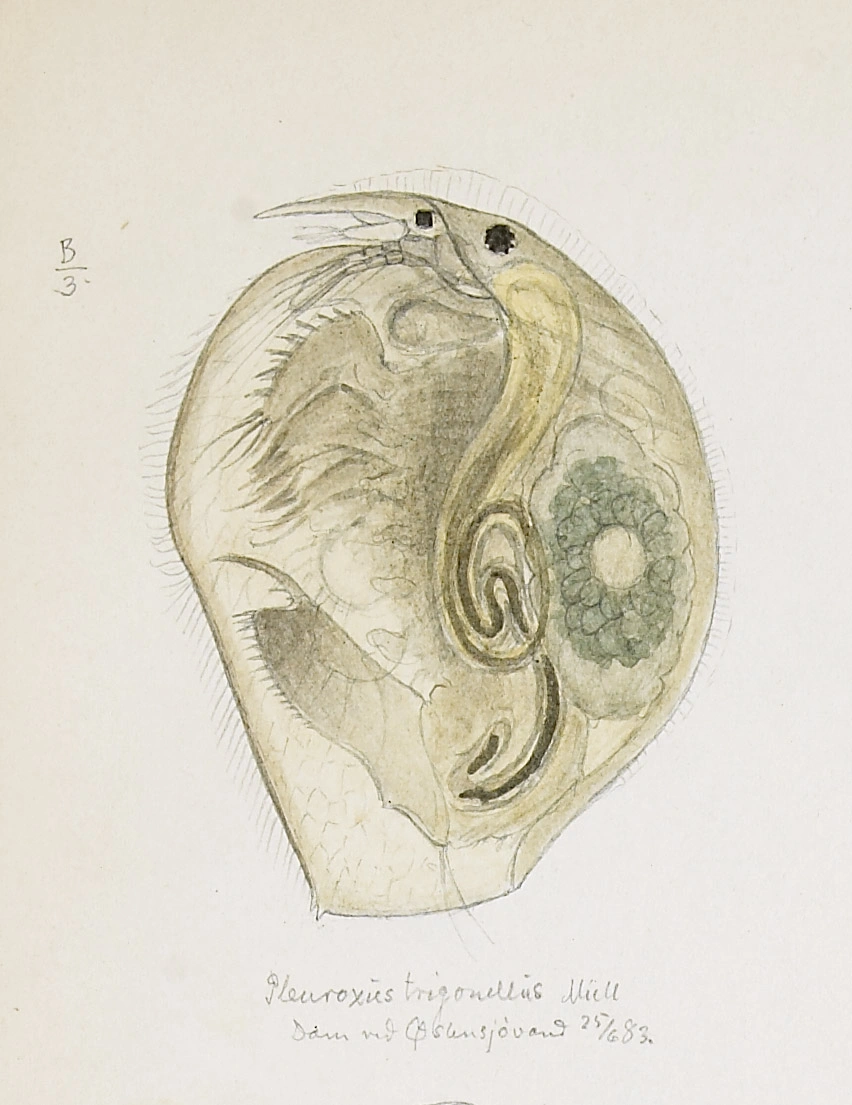Pleuroxus aduncus
Pleuroxus aduncus was first time recorded from a tarn in the Gardermoen area in 1994. It is recognized by 7–10 distinct, curved stripes located dorsally on the anterior part of the carapace.
Key characteristics
Pleuroxus aduncus has a rostrum which is shorter compared to that of relatives within the same genus (Pleuroxus sp). It has 7–10 distinct, curved stripes located dorsally on the anterior part of the carapace. The innermost part of the abdomen is convex while the outermost part, having approximately the same length, decrease in width towards the abdominal claw. The dorsal edge of postabdomen is covered with 7–12 small teeth. Its color is yellow to red brownish, often with a greenish stroke.
Female: Length 0.4–0.8 mm
Male: Length 0.4–0.5 mm
Ecology and distribution
The first record from Norway of Pleuroxus aduncus was from a lake situated in the Gardermoen area in 1994. Later it has been found in a limited number of water bodies, all located in the Oslofjord area, between sea-level and 496 m a.s.l. The size of the localities is within the range 0.1–1000 ha. pH in lakes containing P. aduncus varies between 4.9 and 7.7, while conductivity varies between 0.9 mS/m and 26 mS/m.
| Vitenskapelig navn | < 4,5 | 4,5 - 4,9 | 5,0 - 5,4 | 5,5 - 5,9 | 6,0 - 6,4 | 6,5 - 7,0 | 7,0 - 7,4 | > 7,5 |
|---|---|---|---|---|---|---|---|---|
| 0 | 0,4 | 0 | 0 | 0 | 0,5 | 0 | 0,8 |
| Vitenskapelig navn | < 1,0 | 1,0 - 1,4 | 1,5 - 1,9 | 2,0 - 2,9 | 3,0 - 3,9 | 4,0 - 4,9 | 5,0 - 6,9 | 7,0 - 9,9 | > 10,0 |
|---|---|---|---|---|---|---|---|---|---|
| 0 | 0 | 0,4 | 0 | 0 | 0 | 0 | 0 | 0,9 |
| Vitenskapelig navn | < 0,01 | 0,01 - 0,09 | 0,1 - 0,9 | 1,0 - 9,9 | 10,0 - 99 | 100 - 999 | > 1000 |
|---|---|---|---|---|---|---|---|
| 0 | 0 | 0,5 | 0,2 | 0,3 | 0,5 | 0 |
| Vitenskapelig navn | < 100 | 100-299 | 300-499 | 500-699 | 700-999 | >1000 |
|---|---|---|---|---|---|---|
| 0,7 | 0,2 | 0,3 | 0 | 0 | 0 |
Look-alikes
Pleuroxus trigonellus
